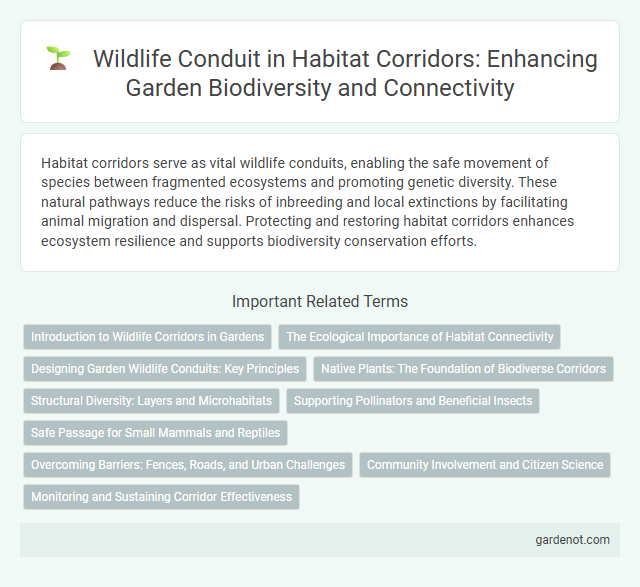Habitat corridors serve as vital wildlife conduits, enabling the safe movement of species between fragmented ecosystems and promoting genetic diversity. These natural pathways reduce the risks of inbreeding and local extinctions by facilitating animal migration and dispersal. Protecting and restoring habitat corridors enhances ecosystem resilience and supports biodiversity conservation efforts.
Introduction to Wildlife Corridors in Gardens
Wildlife corridors in gardens serve as essential conduits that connect fragmented habitats, enabling safe movement for diverse species such as birds, pollinators, and small mammals. Incorporating native plants, water sources, and shelter elements creates an inviting environment that supports biodiversity and enhances ecological resilience. These corridors mitigate habitat isolation caused by urbanization, fostering genetic exchange and improving ecosystem health.
The Ecological Importance of Habitat Connectivity
Habitat corridors serve as vital wildlife conduits, enabling gene flow and species migration essential for population resilience. These connections reduce habitat fragmentation, which otherwise isolates populations and increases extinction risk. Preserving and restoring habitat connectivity supports biodiversity and maintains ecosystem functions by facilitating species movement and access to resources.
Designing Garden Wildlife Conduits: Key Principles
Designing garden wildlife conduits requires integrating native plant species and continuous vegetation to create seamless pathways that support animal movement and biodiversity. Key principles include maintaining corridor width to provide shelter and food resources, minimizing human disturbances, and ensuring connectivity between larger habitat areas. Effective wildlife corridors promote genetic diversity and ecosystem health by enabling safe passage for species such as pollinators, small mammals, and birds.
Native Plants: The Foundation of Biodiverse Corridors
Native plants serve as the essential foundation of wildlife corridors by providing habitat, food, and shelter for diverse animal species. These indigenous flora enhance ecosystem resilience and promote biodiversity by supporting pollinators, birds, and mammals within habitat linkages. Integrating a variety of native plant species ensures the ecological integrity and sustainability of wildlife conduits across fragmented landscapes.
Structural Diversity: Layers and Microhabitats
Wildlife corridors benefit from structural diversity, incorporating multiple vegetation layers such as canopy, understory, and ground cover to enhance habitat complexity. These layers create varied microhabitats that support diverse species by providing food, shelter, and breeding sites. Promoting structural heterogeneity within habitat corridors increases connectivity and resilience for wildlife populations.
Supporting Pollinators and Beneficial Insects
Habitat corridors serve as crucial wildlife conduits that support pollinators and beneficial insects by providing continuous access to diverse flowering plants and nesting sites, enhancing biodiversity and ecosystem resilience. These pathways facilitate gene flow and increase pollination efficiency across fragmented landscapes, essential for agricultural productivity and natural plant reproduction. Conserving and restoring habitat corridors directly boosts populations of key insect species such as bees, butterflies, and predatory beetles that regulate pests and promote healthy ecosystems.
Safe Passage for Small Mammals and Reptiles
Wildlife corridors serve as essential conduits, providing safe passage for small mammals and reptiles to navigate between fragmented habitats. These corridors reduce road mortality and genetic isolation by connecting isolated populations, promoting biodiversity and ecosystem resilience. Effective design incorporates vegetation cover, underpasses, and natural ground structures that cater to the specific movement behaviors of small mammals and reptiles.
Overcoming Barriers: Fences, Roads, and Urban Challenges
Wildlife conduits are essential for overcoming barriers such as fences, roads, and urban development, enabling safe animal movement and gene flow. Innovative solutions like wildlife overpasses, underpasses, and permeable fencing reduce habitat fragmentation and vehicle collisions. These corridors restore ecological connectivity, supporting biodiversity and ecosystem resilience in increasingly urbanized landscapes.
Community Involvement and Citizen Science
Wildlife conduits in habitat corridors benefit significantly from community involvement and citizen science, which enhance data collection on species movement and habitat use. Local volunteers participate in monitoring wildlife activity through camera traps and bioacoustic surveys, generating vital data for conservation planning. Engaging communities fosters stewardship and ensures long-term protection of corridors critical for biodiversity connectivity.
Monitoring and Sustaining Corridor Effectiveness
Monitoring wildlife conduits involves using camera traps, GPS tracking, and remote sensing to gather data on animal movement patterns and corridor usage. Sustaining corridor effectiveness requires adaptive management strategies that address habitat degradation, human-wildlife conflict, and invasive species threats. Regular data analysis supports targeted interventions to maintain connectivity and promote biodiversity conservation within habitat corridors.
Wildlife conduit Infographic

 gardenot.com
gardenot.com